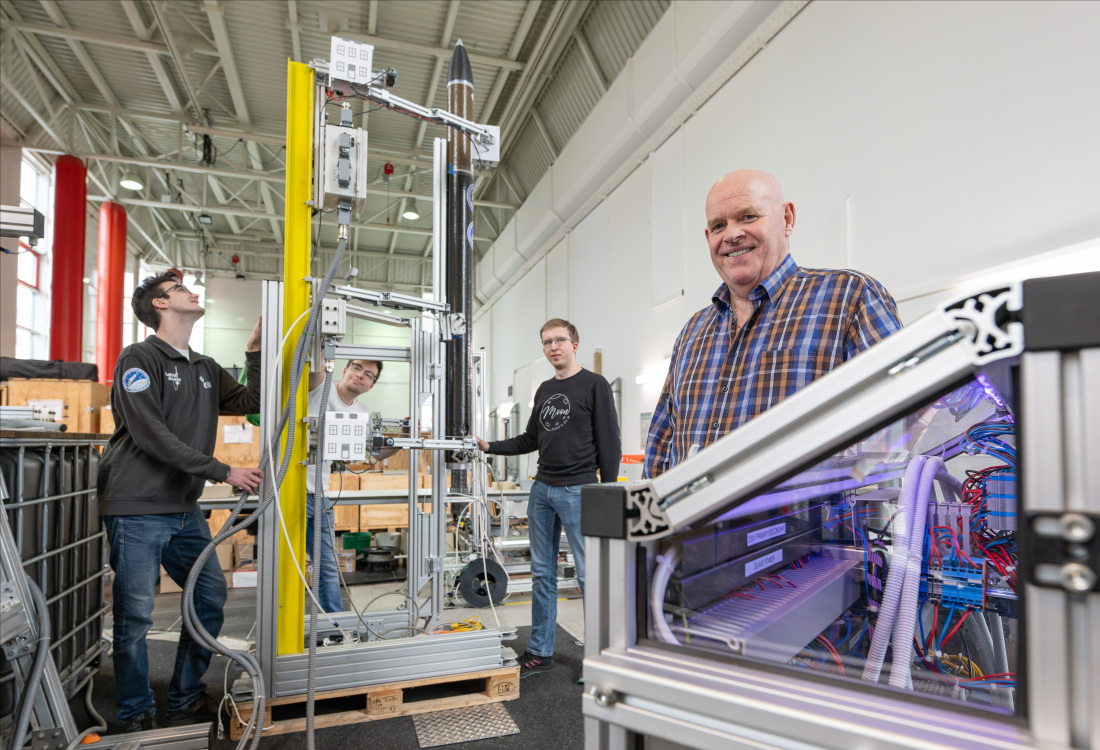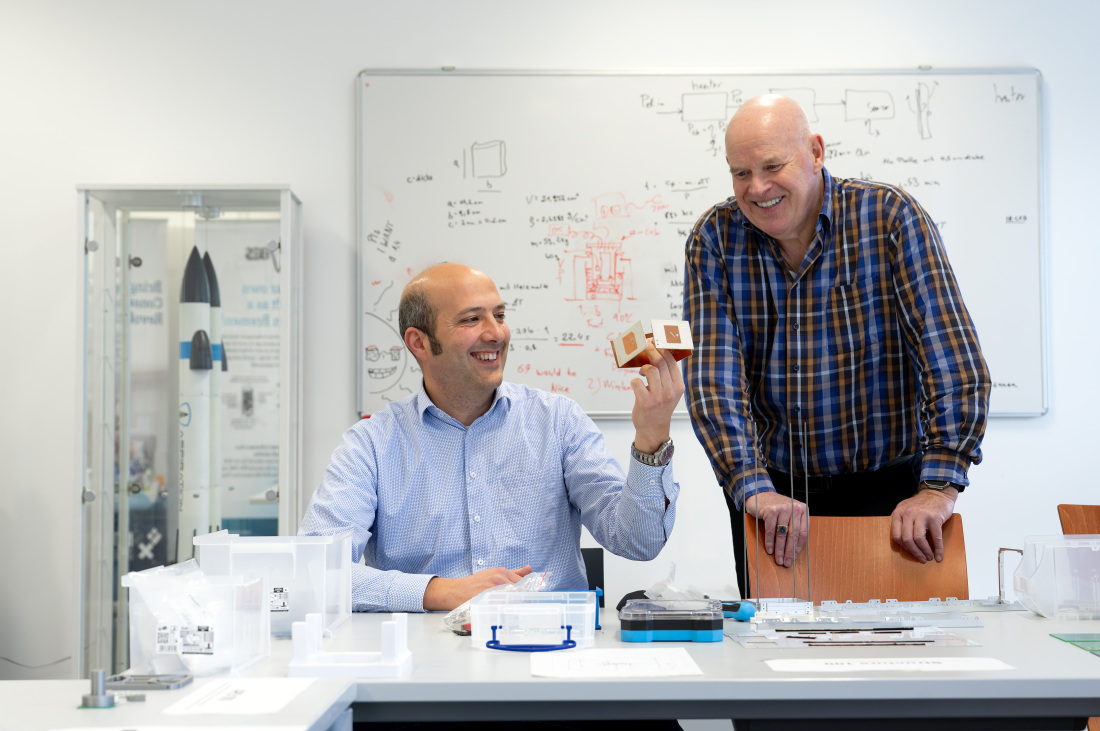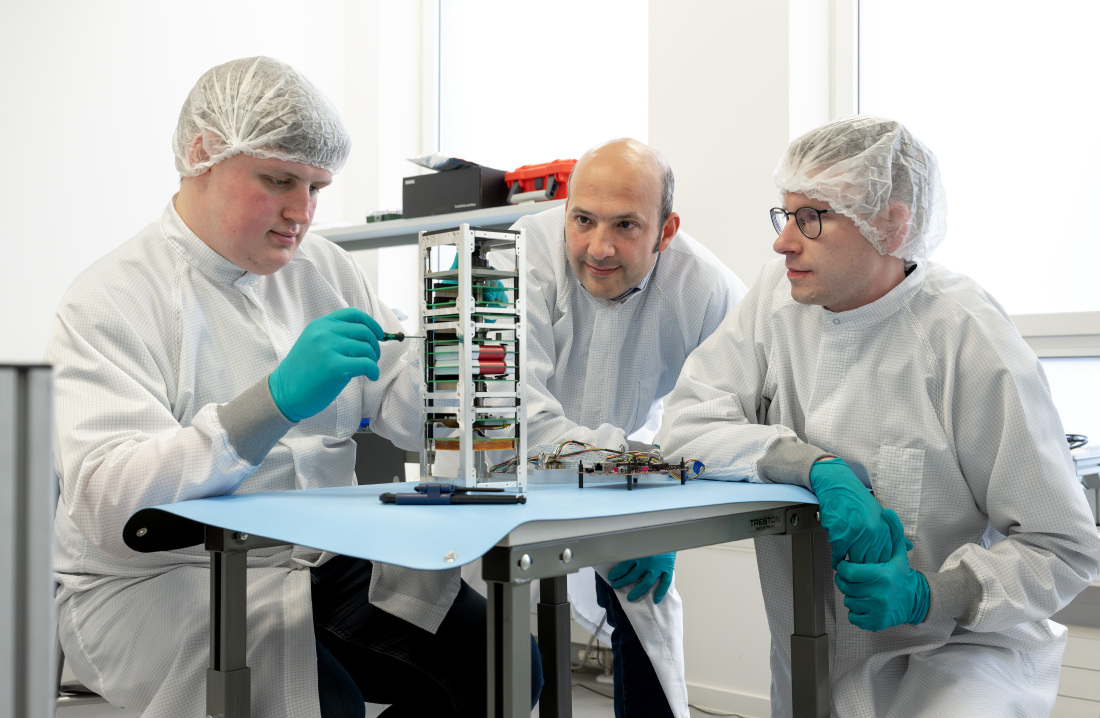Visions for the future of aerospace
AerospaceUniversity institute develops sustainable technology for satellites and rockets

From navigation systems in cars to weather forecasting, we rely heavily on satellites in modern life. But the fuel they require is often toxic. Researchers at the Institute of Aerospace Technology at Bremen University of Applied Sciences are working on more environmentally friendly alternatives. What might the future of aerospace look like?
Images of a rocket launching are nothing short of impressive. At first, flames shoot out of the engines and then the launch pad is shrouded in thick, white clouds as the rocket starts lifting off and gaining speed fast. Those white clouds are mostly steam, created as the water used to cool the launch pad evaporates. In the best case, a mixture of liquid hydrogen and liquid oxygen burns in the rocket engines behind the clouds of steam. But the fuel typically consists of hydrocarbon-based propellants containing nitrogen compounds that are harmful to the environment.
Hydrazine, which is used to fuel rockets and satellites, is a particularly nasty example: “It is not only environmentally harmful due to its emissions, but also extremely toxic in itself,” says Professor Uwe Apel, a researcher and lecturer in aviation and aerospace propulsion systems at Bremen University of Applied Sciences (HSB). “There are even risks associated with the production of this nitrogen and hydrogen compound,” adds his colleague Professor Antonio Francisco Garcia Marin, who specialises in satellite technology at the same university. The two professors are working with other researchers and students to identify more environmentally friendly fuel alternatives at the university’s Institute of Aerospace Technology (IAT).
A major aerospace hub
Apel and Garcia joined the teaching team at Bremen University of Applied Sciences after many years in the aerospace industry. With their combination of technical expertise and extensive practical experience, this pair of professors reflect the unique nature of Bremen as one of the largest centres of excellence in aviation and aerospace. Organisations and research institutes working within the space industry are also based elsewhere, “but Bremen is the only place where the industry and research institutions operate in direct proximity – sometimes even as neighbours,” says Garcia.

Developing aerospace technologies takes time. “The industry focuses primarily on products and processes that can be used commercially in the near future,” says Apel. But, according to both aerospace researchers, if Germany and Europe want to gain access to space independently of other countries, developers need to look well beyond the here and now and focus on the launch of the next generation of rockets.
3.8 million euros of funding for BreSpaceTech 2025+ project
It was on this basis that the university set up the IAT towards the end of the 1990s. The aim is to prepare future technologies and techniques to such an extent that the industry can develop them for commercial use. With funding worth 3.8 million euros from the European Regional Development Fund (ERDF) for the BreSpaceTech 2025+ project, the IAT is now able to create more laboratories and testing facilities.
Common chemical at heart of sustainable satellite fuels
One of the IAT’s priorities is the development of alternative fuels, with a focus on finding a replacement for hydrazine. This highly toxic nitrogen compound is used, for example, to send satellites into space and keep them in position once they’re there. One of the chemical compounds Apel and Garcia are looking into as part of their research is hydrogen peroxide. This liquid hydrogen and oxygen compound is used as a bleaching agent and disinfectant in everyday life. Besides being more environmentally friendly, H2O2 (that’s the chemical formula for hydrogen peroxide) has one other key property that makes it an ideal fuel for satellites: “It already contains the oxygen required for combustion,” says Professor Garcia. Many other fuels require liquid oxygen to be added in special tanks as an oxidiser. Otherwise, there would be no combustion process at all in the combustion chamber of a rocket engine.

“Hydrogen peroxide would be the ideal fuel”
This special property makes hydrogen peroxide an ideal option for satellites and rocket upper stages. Apel and Garcia are optimistic about the market potential of both these applications. “We’re already seeing plenty of small-scale satellites being used for the likes of telecommunications. But this market is bound to grow,” says Garcia with confidence. And this will bring with it a new generation of upper stages that can take these small-scale satellites to their final destinations in space. “Upper stages need engines that can be reignited multiple times so that the payload can be released at different points in space. Hydrogen peroxide would be the ideal fuel” explains Apel.
Through its fuel project, the IAT is operating in a core area of the Bremen aerospace industry. The organisations OHB System AG and Airbus Defence and Space are producing satellites in Bremen, while the French-German ArianeGroup is developing and making the upper stage of the European Ariane 6 launch system here too. “We’re laying the foundations so that the industry can develop commercially viable solutions,” says Professor Apel.
Students develop small-scale digital satellites
The IAT’s work on these projects makes it an important research institute at Bremen University of Applied Science. But it also plays a key role in teaching. For example, resourceful and creative students contribute to the development of small-scale digital satellites – known as CubeSats – in the next generation or the generation after that as part of the ‘Visionary Ingenuity Boosting European Spacecraft’ project.
This affords them the opportunity to pick up the theoretical aerospace basics and learn about how the industry works in practice. The project is divided up into sections that are each allocated to a different year group. “We adhere to industry protocols and document every step so that the next group of students can carry on with the work seamlessly,” explains Professor Garcia. Development work within the industry is structured in a similar way – from the initial design phase to final production.
The first CubeSat produced at the university will be making its way into space on a small rocket in the foreseeable future. Perhaps an alternative fuel from the IAT laboratories will be propelling the microlauncher and small-scale satellite by that point, too.
Success Stories
Take-off for Bremen: what makes the city a hub for aerospace expertise
The sky is not the limit. Science, production, development and business all agree on this. Aircraft wings, Ariane rockets, Galileo satellites - Bremen is one of the top locations in the international aerospace industry. Five reasons for Bremen's success story.
Learn moreLife on Mars
Humans on Mars? Still a distant dream for now. Yet, a Bremen science initiative is developing the foundations for sustainable human life on the Red Planet. This affects Earth, too. After all, these technologies could also be pioneering for the Blue Planet.
Learn moreThe Polymath from Horn-Lehe
No can do? No such thing! GERADTS GMBH makes the things other companies can’t even imagine. This is why this engineering firm is so firmly rooted in major European aviation and aerospace projects, and also in a myriad of other sectors.
Learn more
